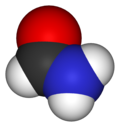Formamide
| |||
| Names | |||
|---|---|---|---|
| IUPAC name
Methanamide
| |||
| Other names
Carbamaldehyde
| |||
| Identifiers | |||
3D model (JSmol)
|
|||
| ECHA InfoCard | 100.000.766 | ||
CompTox Dashboard (EPA)
|
|||
| |||
| Properties | |||
| CH3NO | |||
| Molar mass | 45.04 g/mol | ||
| Density | 1.133 g/cm³ | ||
| Melting point | 2-3 °C | ||
| Boiling point | 210 °C | ||
| Vapor pressure | 0.08 mmHg at 20 °C | ||
| Acidity (pKa) | 23.5 (in DMSO)[1] | ||
| Hazards | |||
| Flash point | 154 °C (closed cup) | ||
Except where otherwise noted, data are given for materials in their standard state (at 25 °C [77 °F], 100 kPa).
| |||
Formamide, also known as methanamide, is an amide derived from formic acid. It is a clear liquid which is miscible with water and has an ammonia-like odor. It is used primarily for manufacturing sulfa drugs and synthesizing vitamins and as a softener for paper and fiber. In its pure form, it dissolves many ionic compounds that are insoluble in water, so it is also used as a solvent.
Formamide is also a constituent of cryoprotectant vitrification mixtures used for cryopreservation of tissues and organs.
Formamide is also used as an RNA stabiliser in gel electrophoresis by deionizing RNA. In capillary electrophoresis, it is used for stabilizing (single) strands of denatured DNA.
Another use is to add it in sol-gel solutions in order to avoid cracking during sintering.
Formamide, in its pure state, has been used as an alternative solvent for the electrostatic self-assembly of polymer nanofilms.[2]
Formamide will begin to partially decompose into carbon monoxide and ammonia at 180°C. When heated strongly, formamide decomposes to hydrogen cyanide (HCN) and water vapor.
Production
In the past, formic acid was reacted with ammonia to produce ammonium formate, which was turned into formamide by heating:
Today's industrial method is based on aminolysis of methyl formate:
Hypothetical Biochemistry
Formamide has also been put forward as an alternative solvent to water, perhaps with the ability to support life with alternative biochemistries to that found on Earth[3].
Self-replication
Formamide is self complimentary and so can cause dissolved carbon monoxide and ammonia to be reacted to form copies of itself. If heated slightly and in the presence of these chemicals, the formamide will slowly grow in quantity.
RNA base creation
Formamide has been shown to create guanine at 130 degrees C in the presence of ultra violet light. [4]
Safety
Formamide is highly corrosive on contact with skin or eyes and may be deadly if ingested. Inhalation of large amounts of formamide vapor may require medical attention.[5] It is also a teratogen[6] Formamide should never be handled without proper safety attire including gloves and goggles.
References
- ^ F. G. Bordwell, J. E. Bartmess and J. A. Hautala (1978). "Alkyl effects on equilibrium acidities of carbon acids in protic and dipolar aprotic media and the gas phase". J. Org. Chem. 43 (16): 3095–3101. doi:10.1021/jo00410a001.
- ^ Vimal K. Kamineni, Yuri M. Lvov, and Tabbetha A. Dobbins (2007). "Layer-by-Layer Nanoassembly of Polyelectrolytes Using Formamide as the Working Medium". Langmuir. 23 (14): 7423–7427. doi:10.1021/la700465n.
{{cite journal}}: CS1 maint: multiple names: authors list (link) - ^ http://www.astrobio.net/news/article2171.html
- ^ http://www.sciencedaily.com/releases/2010/06/100614101957.htm
- ^ http://www.jtbaker.com/msds/englishhtml/f5770.htm
- ^ http://www.bath.ac.uk/internal/bio-sci/bbsafe/formamide.htm


